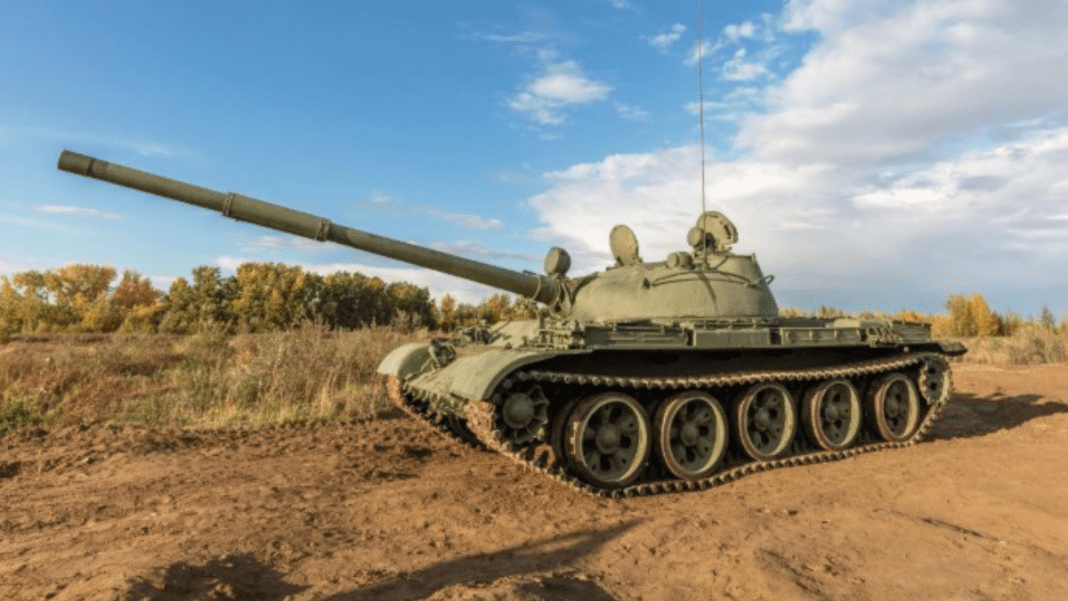According to Ukrainian defense intelligence, Russia is now returning old Soviet-era T-62 tanks to the front lines due to a growing shortage of modern armored vehicles.
Severe Shortage Forces Russia to Reactivate T-62 Tanks
These tanks, originally designed in the early 1960s and widely used during the Cold War, are being brought out of long-term storage. The move comes as a response to heavy equipment losses and a decline in Russia’s ability to produce newer tanks like the T-90M or T-72B3M.
Ukrainian intelligence reports that Russia has already run out of a large portion of the armored vehicles produced in the 1970s. Now, they are reportedly restoring even older combat tanks. The T-62s are being prepared and refurbished for use despite their outdated technology and design.
This decision signals how serious the shortage of modern equipment has become. The Russian military is bringing back old tanks from storage facilities located mostly in the Eastern Military District. They stored these machines in open areas for many years, which exposed them to weather and caused their technical condition to deteriorate due to a lack of maintenance. On June 27, observers recorded the movement of 21 such T-62 tanks from the eastern part of Russia to the European side.
Fuel Tanks That Vanish? Israeli F-35I Adir Carried the Secret That Changed the Combat Gam
T-62 Tanks Restored at Remote Military Repair Facilities
The restoration of these outdated tanks is taking place at specific military repair plants. One such facility is the 103rd Armored Repair Plant, located in Atamanovka in Zabaykalsky Krai. Here, old tanks are cleaned, repaired, and sometimes modified for limited combat use. Many of these tanks require extensive work because of rust, missing parts, or internal damage caused by long-term storage.
Despite these efforts, most of the reactivated T-62s do not meet the standards of modern warfare. The tanks lack the advanced armor, targeting systems, and speed that newer models offer. Still, Russian military forces are using these vehicles because of urgent battlefield demands and limited alternatives.
🏭 Tanks Over Sanctions: Russia’s Answer to Battlefield Losses Is the T-90M “Proryv”
Russian forces are not using these restored tanks solely in traditional combat roles. Ukrainian intelligence claims that in many cases, they deploy the tanks as stationary firing points. They position them in defensive areas to provide extra firepower, even if the tanks are no longer fully mobile. This tactic reflects how stretched Russian resources have become.
Production Gaps Limit Access to Modern Combat Vehicles
Russia’s defense industry is facing serious challenges that prevent it from replacing lost tanks with modern versions. The production of advanced models like the T-90M and T-72B3M has slowed significantly due to two key reasons. First, the industrial capacity to build high-tech military vehicles is limited. Second, many of the essential parts for modern tanks, especially electronics and targeting components, rely on imported technology that is no longer easily available.
Because of these limitations, Russian forces are unable to build enough new tanks to replace those lost in battle. As a result, the military is increasingly relying on whatever armored vehicles are still available—even if they are several decades old and in poor condition.
The shortage is considered so critical that the Russian command is left with little choice but to reintroduce tanks that were never meant to return to modern battlefields. This includes T-62 models that were once considered outdated and retired from frontline use.
Ghost Ship Jaguar Defies Estonia in Baltic Sea, Russian Jet Shields Tanker from Interception
This unusual step reflects a broader issue within Russia’s defense supply chain. The country is facing both logistical and technological hurdles in sustaining its current military efforts. Military commanders view bringing back older vehicles like the T-62 as a temporary fix to a growing equipment crisis, which may have long-term effects on operational capability.

